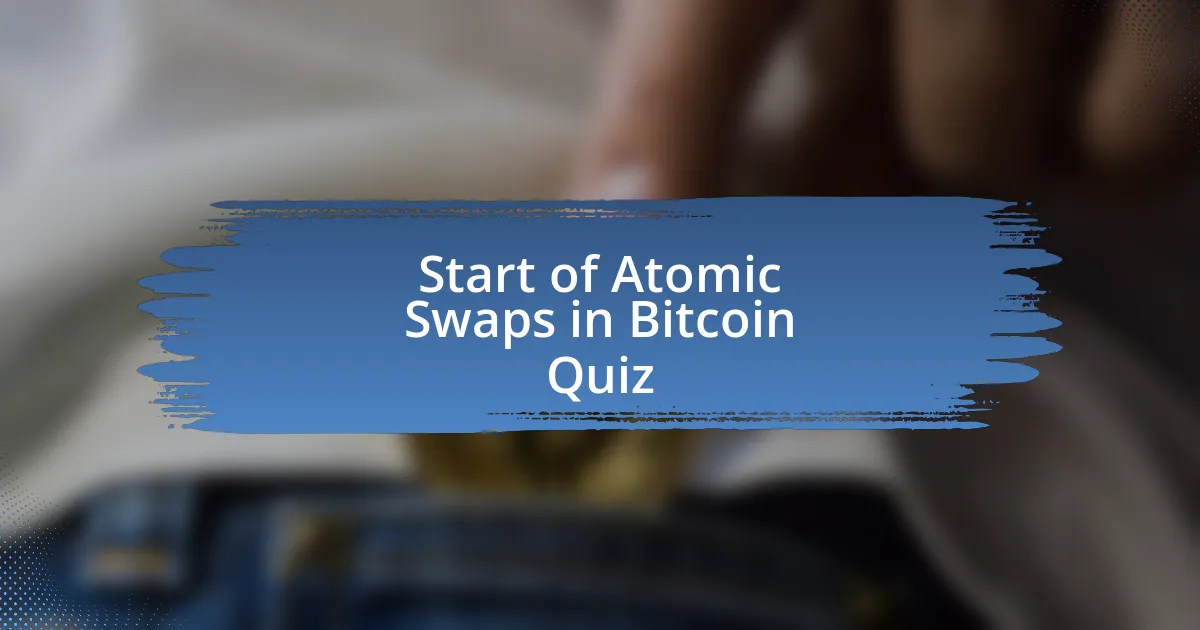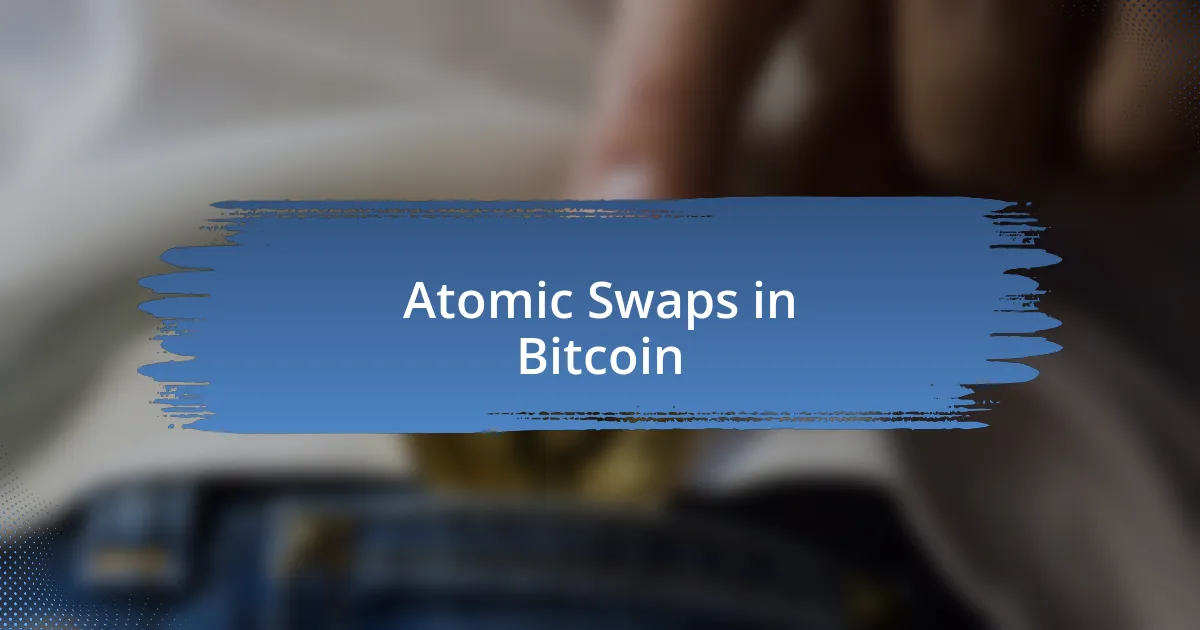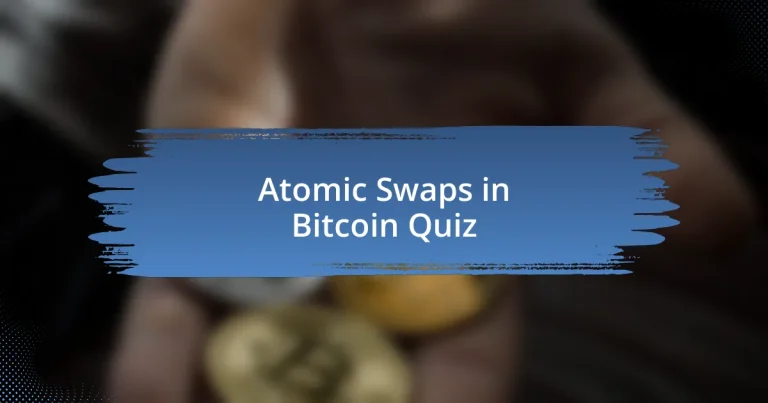
Start of Atomic Swaps in Bitcoin Quiz
1. What is an Atomic Swap?
- An Atomic Swap is a type of cryptocurrency wallet used for storage.
- An Atomic Swap is a method to mine cryptocurrencies more efficiently.
- An Atomic Swap is a trading platform for non-fungible tokens (NFTs).
- An Atomic Swap is an exchange of cryptocurrencies from separate blockchains without the need for centralized intermediaries.
2. What is the primary goal of Atomic Swaps?
- To simplify user registrations
- To remove centralized intermediaries
- To increase transaction fees
- To convert fiat currencies easily
3. What is Hash Time-Locked Contract (HTLC)?
- A simple agreement between two parties to share funds without any conditions.
- A class of payments that use hash-locks and time-locks requiring the receiver to acknowledge payment prior to a deadline.
- A type of contract that is automatically executed without human intervention.
- A digital receipt that confirms the ownership of a cryptocurrency.
4. What is Time-Locked Contract?
- A contract that prevents any party from accessing their funds indefinitely.
- A contract that locks a transaction for a specific period, ensuring the transaction happens as agreed by both parties.
- A contract that allows transactions to happen instantly without any delays.
- A contract that requires both parties to meet in person to finalize the transaction.
5. How does an Atomic Swap transaction proposal begin?
- The initiator proposes a trade outlining the details, including the amount and type of cryptocurrency to be swapped.
- The initiator transfers funds directly to the participant before the proposal.
- The participant creates a new blockchain for the transaction.
- Both parties agree on a centralized exchange to process the trade.
6. What is the role of HTLC in an Atomic Swap?
- The initiator locks the entire transaction without the participant`s consent.
- The initiator creates an HTLC and sends the proposed cryptocurrency, generating a hash and cryptographic puzzle for the participant to solve.
- The initiator creates a traditional escrow account to hold the funds during the swap.
- The initiator transfers the cryptocurrency directly to the participant without conditions.
7. What does the participant do after receiving the HTLC?
- The participant verifies the transaction details and creates their own HTLC.
- The participant immediately completes the transaction without checks.
- The participant sends their funds to a random address.
- The participant cancels the transaction and withdraws the funds.
8. What happens during Solution Sharing in an Atomic Swap?
- The initiator sends a new proposal for a different trade.
- The participant solves the initiator`s cryptographic puzzle, sharing the solution with the initiator.
- The funds are transferred instantly to a central exchange.
- The participant must wait for external verification of the transaction.
9. What is the purpose of creating a contract in an Atomic Swap?
- To specify the terms of the transaction, including the amount of cryptocurrency to be traded and a unique cryptographic hash value.
- To maintain a public ledger of all transactions and identify the users involved in the swap.
- To create a centralized authority for overseeing the transaction process and ensuring compliance.
- To allow unlimited time for both parties to change their minds about the transaction terms.
10. How does Alice lock her funds in an Atomic Swap?
- Alice keeps her funds in her wallet for a fixed duration without locking them.
- Alice locks her funds into the contract using her private key, setting a time limit for the transaction to be completed.
- Alice transfers her funds to a public address for maximum security during the swap.
- Alice secures her funds by sending them to a centralized exchange account.
11. What does Alice do after locking her funds?
- Alice cancels the transaction immediately.
- Alice waits for Bob to initiate the transaction.
- Alice withdraws her locked funds.
- Alice shares the contract address with Bob.
12. What does Bob do after receiving the contract address?
- Bob ignores the contract address and moves on.
- Bob verifies the contract address and the locked funds.
- Bob cancels the transaction immediately.
- Bob shares the contract address with Alice.
13. What happens if either party fails to unlock the funds within the time limit?
- The funds are permanently lost and cannot be retrieved.
- A penalty fee is deducted from the funds for the delay.
- The trade is automatically canceled, and the funds return to their original owners.
- The transaction is delayed but eventually completes later.
14. What is the benefit of using atomic swaps over centralized exchanges?
- Atomic swaps require approval from centralized authorities before transactions can occur.
- Atomic swaps reduce the need for lengthy series of steps and transaction fees associated with centralized exchanges.
- Atomic swaps increase transaction fees compared to centralized exchanges.
- Atomic swaps are slower due to multiple intermediaries involved.
15. How do atomic swaps use smart contracts?
- Atomic swaps use smart contracts that lock or burn the original tokens and issue new ones on the corresponding blockchains.
- Atomic swaps depend on third-party platforms that handle the cryptocurrency exchange and guarantee fund safety.
- Atomic swaps apply smart contracts that allocate funds based on the user`s trading history and reputation score.
- Atomic swaps utilize middleware that processes the transactions through a centralized server for efficiency.
16. What is the term `atomic` referring to in atomic swaps?
- The transaction either happens or it doesn`t.
- The transaction is delayed for further verification.
- The transaction requires multiple confirmations.
- The transaction can be reversed after completion.
17. What is the role of decentralized exchanges (DEXs) in atomic swaps?
- DEXs provide insurance for trades executed through them.
- DEXs act as custodians for the users` funds during trades.
- DEXs require user verification for all transactions.
- DEXs can facilitate peer-to-peer trades without central intermediaries.
18. How do atomic swaps ensure trustless exchanges?
- Atomic swaps use escrow services that hold the funds until both parties confirm the transaction manually.
- Atomic swaps rely on centralized exchanges to manage trust issues and guarantee transaction completion.
- Atomic swaps use HTLCs and smart contracts to automate the exchange process, ensuring that each party agrees to the transaction before a timer runs out.
- Atomic swaps depend on third-party validators to ensure both parties fulfill their obligations during the exchange.
19. What happens during the transaction completion phase of an atomic swap?
- Both parties subtract transaction fees from their balances at once.
- Bob can send Alice a confirmation message to complete the swap.
- Alice and Bob must create new accounts to finalize the trade.
- Alice can unlock Bob`s funds using her private key.
20. What is the significance of using Hashed Time Lock Contracts (HTLCs) in atomic swaps?
- HTLCs provide an extra layer of fees for transactions.
- HTLCs automatically convert tokens to fiat currency.
- HTLCs ensure timely execution of the swaps.
- HTLCs are used solely for off-chain transactions.
21. How do atomic swaps facilitate peer-to-peer trading mechanisms?
- Atomic swaps facilitate peer-to-peer trading by allowing users to exchange cryptocurrencies directly without the need for trusted third parties.
- Atomic swaps require users to deposit their funds into a third-party wallet before trading.
- Atomic swaps mandate the use of traditional banking systems to facilitate the trades.
- Atomic swaps create a centralized exchange to trade tokens for users with higher security.
22. What is the primary mechanism behind atomic swaps?
- Peer-to-peer messaging
- Smart contracts that lock or burn tokens
- Digital wallets storing cryptocurrencies
- Centralized exchanges where trades occur
23. What are the benefits of using atomic swaps?
- Atomic swaps restrict users to exchanging cryptocurrencies within the same blockchain.
- Atomic swaps eliminate the need for any form of verification in transactions.
- Atomic swaps are faster and generally cheaper than going through exchanges or other token swap service providers.
- Atomic swaps increase reliance on centralized exchanges to facilitate trades.
24. Are atomic swaps anonymous?
- Atomic swaps require user identification.
- In most cases, atomic swaps are pseudonymous.
- Atomic swaps are fully anonymous.
- Atomic swaps are entirely open and public.
25. How do atomic swaps handle failed transactions?
- The funds remain locked indefinitely until both parties agree.
- The losing party pays a penalty fee to the winning party.
- The trade is automatically canceled, and the funds return to their original owners.
- The transaction is completed regardless of the time limit set.
26. What is the process for exchanging ETH for BTC via an atomic swap?
- Create a transaction wallet, exchange ETH for BTC, and share keys.
- Open a crypto exchange, sell ETH for USD, and buy BTC with it.
- Generate an HTLC smart contract, deposit ETH, and confirm BTC deposit.
- Transfer ETH to a friend, have them send BTC back, and confirm securely.
27. What happens if either party fails to retrieve the other’s funds before the deadline?
- The funds are permanently lost to both parties.
- The funds are transferred to a third party as a penalty.
- The transaction is completed anyway, regardless of the deadline.
- The transaction is canceled, and the funds return to their original owners.
28. How do atomic swaps reduce inefficiencies in cryptocurrency exchanges?
- Atomic swaps use physical cash to facilitate exchanges between users.
- Atomic swaps remove the need for intermediaries, streamlining transactions.
- Atomic swaps rely on manual processes to complete trades efficiently.
- Atomic swaps require a third-party verification for every transaction.
29. What is the role of smart contracts in facilitating atomic swaps?
- Smart contracts automate the exchange by locking or burning tokens.
- Smart contracts collect transaction fees for each swap made.
- Smart contracts verify user identities before transactions proceed.
- Smart contracts create a marketplace for users to trade tokens.
30. How do atomic swaps ensure that each party agrees to the transaction?
- Atomic swaps rely on manual confirmations from each party before the transaction proceeds.
- Atomic swaps require third-party intermediaries to validate the agreement between parties.
- Atomic swaps use HTLCs and smart contracts to ensure that each party agrees to the transaction before a timer runs out.
- Atomic swaps enforce transactions only through verbal agreements between participants.

Congratulations! You’ve Successfully Completed the Quiz on Atomic Swaps in Bitcoin
Thank you for taking the time to engage with our quiz on atomic swaps in Bitcoin. We hope you found it both enjoyable and enlightening. This topic highlights a crucial aspect of decentralized exchanges, empowering users to trade directly without intermediaries. Understanding atomic swaps can deepen your appreciation for the innovations in cryptocurrency technology.
As you navigated through the questions, you likely learned about the mechanics of atomic swaps, how they enhance security, and the significant benefits they offer for peer-to-peer transactions. This knowledge is vital for any cryptocurrency enthusiast looking to grasp the future of digital trading. You now possess insights that can help you navigate the evolving landscape of blockchain technology.
We invite you to check out the next section on this page, which provides detailed information about atomic swaps in Bitcoin. This rich content will further expand your understanding and equip you with valuable skills to leverage these innovations. Discover the intricacies of atomic swaps and how they are shaping the future of cryptocurrency transactions. Happy learning!

Atomic Swaps in Bitcoin
Understanding Atomic Swaps in Bitcoin
Atomic swaps enable direct cryptocurrency exchanges between different blockchains without reliance on intermediaries. This process leverages smart contracts to ensure that both parties fulfill their obligations. If one party fails to complete their transaction, the trade is canceled, providing a safeguard against fraud. This technology facilitates peer-to-peer transactions, enhancing decentralization and security.
How Atomic Swaps Work
Atomic swaps utilize hashed time-locked contracts (HTLCs) to guarantee transactions. In this setup, a user creates a transaction that involves a hash of a secret. The counterpart can redeem the transaction only by providing the corresponding secret. If the secret isn’t revealed within a specified time frame, the funds return to the original owner, assuring that trades are fair and secure.
Advantages of Atomic Swaps
Atomic swaps offer several benefits, including increased privacy and reduced costs. Users do not need to rely on centralized exchanges, which often charge fees and require personal information. Additionally, atomic swaps minimize counterparty risk since transactions occur directly between users. This technology promotes financial autonomy and enables better control over assets.
Challenges Facing Atomic Swaps
Despite their benefits, atomic swaps face challenges, such as compatibility issues between blockchains. Not all cryptocurrencies support the necessary technologies for atomic swaps, limiting their use. Additionally, users may risk losing funds if they do not fully understand the process. This complexity can deter less experienced users from adopting atomic swap technology.
Future of Atomic Swaps in Bitcoin
The future of atomic swaps in Bitcoin looks promising, with ongoing technological advancements. Developers are working to enhance interoperability across more cryptocurrencies. As decentralized finance (DeFi) gains popularity, atomic swaps could become a standard feature in trading. This shift may encourage broader adoption and trust in blockchain technology, further revolutionizing the financial landscape.
What are Atomic Swaps in Bitcoin?
Atomic swaps are a technology that allows for the direct exchange of different cryptocurrencies between users without the need for a centralized exchange. This process executes a smart contract that ensures the trade only happens if both parties fulfill their conditions. For example, Bitcoin can be exchanged for Ethereum directly between two wallets. This enhances security and control for users, as funds are never held by a third party.
How do Atomic Swaps work?
Atomic swaps use hash time-locked contracts (HTLC) to secure the transaction. Each party generates a cryptographic hash and shares it with the other party. If the first party makes the exchange, the second party can claim the funds using the hash. If the transaction fails, funds can be returned after a predefined time, ensuring that no party loses money. This process ensures trustless and secure trading.
Where can Atomic Swaps be executed?
Atomic swaps can be executed on compatible wallets that support the technology. Some well-known wallets include Atomic Wallet and Binance DEX. These platforms allow users to swap cryptocurrencies directly. Additionally, exchanges like Decred’s decentralized exchange (DEX) also utilize atomic swap technology, showing its practical application within the cryptocurrency ecosystem.
When were Atomic Swaps introduced in Bitcoin?
Atomic swaps were introduced in 2013 but gained significant attention with the implementation of the technology in 2017. A notable example occurred when Litecoin and Bitcoin conducted their first successful atomic swap. This marked a turning point, demonstrating the feasibility of cross-chain transactions and showcasing the potential for decentralized trading solutions.
Who created the concept of Atomic Swaps?
The concept of atomic swaps was proposed by Tier Nolan, a developer from the Bitcoin community, in 2013. It was later brought to life through collaboration among various cryptocurrency developers, including those from the Litecoin and Decred projects. Their work included the development of hash time-locked contracts, which are foundational to the functioning of atomic swaps.


